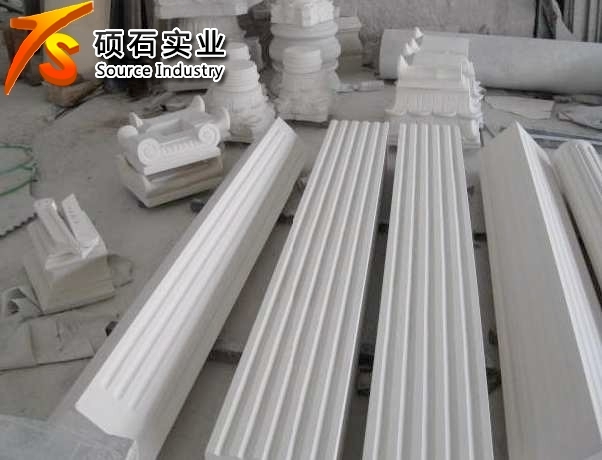We offer large selections of stone & marble columns pillars for the exterior and interior of public
buildings and private houses. Most popular styles are Roman columns, Tuscan columns, Doric
order, Ionic order, Corinthian Order Composite Order and Solomonic columns.
The Doric order is the oldest and simplest of the classical orders. It is composed of a vertical
cylinder that is wider at the bottom. It generally has neither a base nor a detailed capital. It is
instead often topped with an inverted frustum of a shallow cone or a cylindrical band of carvings.
It is often referred to as the masculine order because it is represented in the bottom level of the
Colosseum and the Parthenon, and was therefore considered to be able to hold more weight. The
height-to-thickness ratio is about 8:1;
The Tuscan order, also known as Roman Doric, is also a simple design, the base and capital both
being series of cylindrical disks of alternating diameter. The shaft is almost never fluted. The proportions vary, but are generally similar to Doric columns. Height to width ratio is about 7:1.
The Ionic column is considerably more complex than the Doric or Tuscan. It usually has a base
and the shaft is often fluted (it has grooves carved up its length). On the top is a capital in the
characteristic shape of a scroll, called a volute, or scroll, at the four corners. The
height-to-thickness ratio is around 9:1. Due to the more refined proportions and scroll capitals, the
Ionic column is sometimes associated with academic buildings.
The Corinthian order is named for the Greek city-state of Corinth, to which it was connected in
the period. However, according to the architectural historian Vitruvius, the column was created by
the sculptor Callimachus, probably an Athenian, who drew acanthus leaves growing around a
votive basket. In fact, the oldest known Corinthian capital was found in Bassae, dated at 427 BC.
It is sometimes called the feminine order because it is on the top level of the Colosseum and
holding up the least weight, and also has the slenderest ratio of thickness to height. Height to
width ratio is about 10:1.
The Composite order draws its name from the capital being a composite of the Ionic and
Corinthian capitals. The acanthus of the Corinthian column already has a scroll-like element, so
the distinction is sometimes subtle. Generally the Composite is similar to the Corinthian in
proportion and employment, often in the upper tiers of colonnades. Height to width ratio is about
11:1 or 12:1.
Solomonic columns were inventions of Baroque architects in Europe. They were not used in
antiquity, but were called "Solomonic" by baroque architects because they were based on a description of columns in the great temple of King Solomon in the Old Testament.
A Solomonic column begins on a base and ends in a capital, just like a classical column, but the shaft twists
around the usual parameters of a column, producing a dramatic, serpentine effect of movement.
The stone and marble columns & pillars are available in solid or hollow finish. Main materials
used are various natural marble, sandstone, travertine and limestone. The columns are normally
made in three sections which include capital, shaft and base. Any custom dimensions and design
can be made by our factory. Normal sizes for exterior columns are up to 8ft height by 12 inches
shaft diameter. The shaft can be fluted or plain, tapered or round. Polished, honed, flamed ,antic
and bush-hammered finishing are all available on different material.

